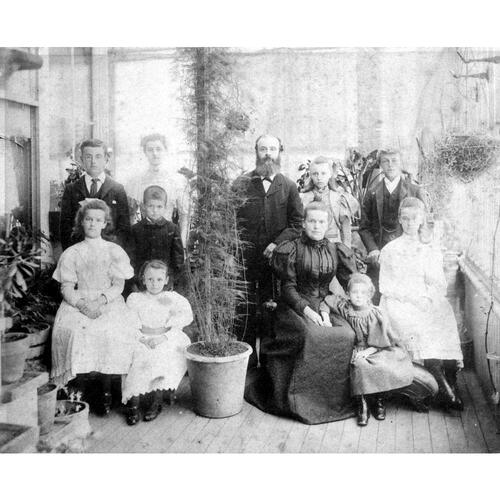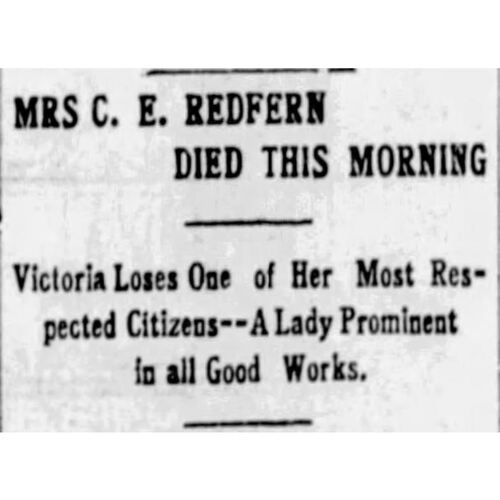![Charles Edward Redfern and family [ca. 1894]. Source: RBCM Archives Original title: Charles Edward Redfern and family [ca. 1894]. Source: RBCM Archives](/bioimages/w600.15476.jpg)
Source: Link
ROBINSON, ELIZA ARDEN (Redfern), homemaker and social reformer; b. c. 1852 in St Neots, England, daughter of William Augustus Robinson; m. 5 Oct. 1877 Charles Edward Redfern in Victoria, and they had six daughters and three sons; d. there 19 March 1906.
On the day of Eliza Robinson Redfern’s death, flags on public buildings in Victoria were flown at half-mast. The evening newspaper, the Victoria Daily Times, featured the unhappy report in the centre of the front page. For more than a quarter-century Mrs Redfern had been in the public spotlight as a child advocate and as the wife of a prominent businessman and sometime politician.
In many respects her life was a conventional one. Like most women of her generation, she structured it around two principal roles, those of wife and mother. The daughter of an Irish Anglican clergy-man, she had journeyed to Victoria as a young single woman in 1875 and there she met Charles Redfern. They were married in October 1877 at the Church of St John the Divine, and she soon became involved with the responsibilities of motherhood; she bore their first child only 11 months later and eight more children during the next 12 years. All would reach adulthood.
The unconventional aspects of Eliza Redfern’s life lay in her involvement in the public sphere. Initially her public appearances derived entirely from her relationship to her husband. At the time of their marriage Charles Redfern was well established in Victoria as the proprietor of a jewellery and watchmaking business and the alderman for James Bay Ward on the municipal council. Through him she became a member of Victoria’s somewhat elastic social élite, which incorporated the families of businessmen and politicians as well as those of professional men, senior clerics, and English gentry. Recognition of the change in her social standing came quickly. On their wedding night the Redferns were among the invited guests at a naval ball in Esquimalt hosted by the commander-in-chief of Her Majesty’s naval forces in the Pacific. An account of the ball and the names of all the guests were duly reported in the morning newspaper. This introduction to the limelight served Eliza Redfern well since her husband’s status continued to rise with his increasing involvement in schemes for civic betterment and his terms as mayor of Victoria in 1883, 1897, 1898, and 1899.
Eliza Redfern was not content, however, with her assigned position as full-time home-maker and mother. As much as time and energy permitted, she began to volunteer her services for the improvement of the conditions facing Victoria’s least fortunate residents. Like a number of her contemporaries there and in other Canadian cities and towns, Mrs Redfern adopted the idea that women might appropriately extend their role as mothers from the confines of the family home to the community at large. She chose to direct her energies to the “child savers” contingent of the social reform movement. In her husband’s name she contributed food and money to the British Columbia Protestant Orphans’ Home. The Friendly Help Society, which was connected with the Local Council of Women of Victoria and Vancouver Island, also benefited from her largesse in its distribution of food, milk, fuel, and furniture to the city’s most needy residents. But it was the Children’s Aid Society of Victoria, created in 1901 with the passage of the Children’s Protection Act of British Columbia, that received her full attention. Dedicated to the prevention of cruel or neglectful treatment, the CAS attempted to improve the child’s existing home through education and assistance, an approach based on the notion of sanctity of the family unit. But in the case of homeless or orphaned children or of households in which the offending adult was recalcitrant, the society intervened and placed children in foster homes. Eliza Redfern was particularly adept at finding families willing to welcome homeless children into their midst. According to her fellow members, she worked tirelessly on behalf of the society, an effort which was acknowledged in her position as vice-president from 1904 until her death in 1906. Her extensive involvement in the affairs of the CAS placed her at the front of the ranks of women attempting to improve the quality of life in Canada at the turn of the century.
ACC, Diocese of British Columbia Arch. (Victoria), Church of St John the Divine (Victoria), RBMB, 5 Oct. 1877, 1878–90. BCARS, Add. mss 431, 1901–6. Daily Colonist (Victoria), 1877–1906; 20 March 1906; 27 March 1929; 8 May 1949, magazine sect.: 10. Victoria Daily Tines, 1901–6; 19 March 1906; 27 March 1929. British Columbia Protestant Orphans’ Home, Constitution and by-laws; incorporated under the Benevolent Societies Act ([Victoria?, 1892?]); Report (Victoria), 1888–95. Kerr, Biog. dict. of British Columbians. NCWC Year book, 1898. Scholefield and Howay, British Columbia, vol.4. Who’s who in western Canada . . . , ed. C. W. Parker (2v., [Vancouver?], 1911–12), 1.
Cite This Article
Linda L. Hale, “ROBINSON, ELIZA ARDEN (Redfern),” in Dictionary of Canadian Biography, vol. 13, University of Toronto/Université Laval, 2003–, accessed January 1, 2026, https://www.biographi.ca/en/bio/robinson_eliza_arden_13E.html.
The citation above shows the format for footnotes and endnotes according to the Chicago manual of style (16th edition). Information to be used in other citation formats:
| Permalink: | https://www.biographi.ca/en/bio/robinson_eliza_arden_13E.html |
| Author of Article: | Linda L. Hale |
| Title of Article: | ROBINSON, ELIZA ARDEN (Redfern) |
| Publication Name: | Dictionary of Canadian Biography, vol. 13 |
| Publisher: | University of Toronto/Université Laval |
| Year of publication: | 1994 |
| Year of revision: | 1994 |
| Access Date: | January 1, 2026 |




